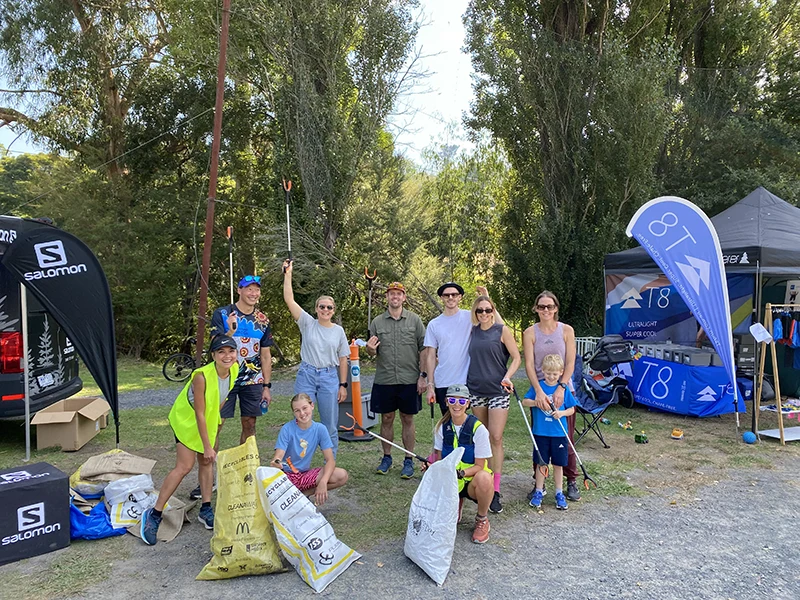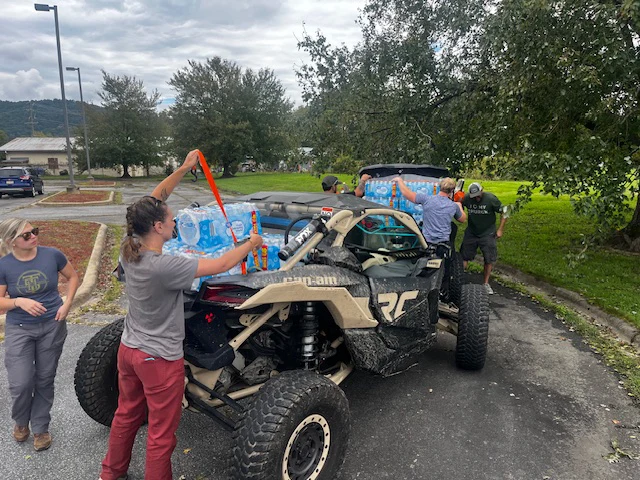

Photo credits in captions, other media courtesy of David Huff
The first time my husband and I went to find our section of the Appalachian Trail, we drove slowly down Rice Creek Road in Flag Pond, Tennessee. It was a windy, narrow road with no end. We heard a voice coming from the porch of a modest house. “You’re looking for the Government land?” an old man in a rocking chair asked.
“Yes sir. We’re looking for the Appalachian Trail. We’re the new section maintainers with Carolina Mountain Club.”
“Just keep going,” He pointed further into the holler.
The road seemed to be swallowed up by trees. At the end of the lane, we found one obvious place to park and an encouraging trail up. We walked up with our pack unsure what we would find. Finally, we reached the A.T. at Rice Gap with its reassuring white blazes. Whew!

The Start of Carolina Mountain Club
In the years after World War I, The Appalachian Mountain Club in Boston was a thriving hiking club looking to expand beyond the Northeast. Phillip P. Ayres, the president of AMC, traveled to Asheville to encourage the formation of a Southern chapter. According to the Asheville Citizen, June 4, 1919, “As the capital of the southern highlands, Asheville has a special interest in that for which the Appalachian Mountain Club stands.”
Ayres acknowledges that the Southern Highlands has “many mountains higher than Mt. Washington” – something that even present-day northern hikers have trouble accepting. “People would be led to make themselves familiar with the wonders of nature which now for practical purposes are as remote as the North Pole.”

Over forty men and women joined the club. The Northerners saw this as the beginning of a Hut and Trail system, similar to the ones being built in New Hampshire. But the southern chapter didn’t last long. The eight-dollar dues (now worth over $138) were mostly slated to go back north to boost the income and hut development of AMC. That didn’t sit well with the Asheville group. They separated from the mothership in Boston under amicable terms and regrouped.
A new club, Carolina Mountain Club (CMC), was created July 16, 1923, a club that just celebrated its 100th Anniversary as the oldest outdoor club in the Southeast. Dr. Gaillard Stoney Tennent became its first president – the same Tennent of Tennent Mountain on the Art Loeb Trail in Pisgah National Forest. The purpose of CMC was to create and stimulate interest in the outdoors - camping, walking, mountain climbing, fishing, hunting, and winter sports. At the time CMC was going to do it all.

As the years went on, the group first focused on hiking and building the A.T. By the 1960s, CMC maintained eighty miles of the A.T. in North Carolina. But group maintenance and work parties were not enough.

Start of Section Maintenance
In 1973, Jack Davis, president of CMC, and the Council proposed section maintenance. The primary responsibility was to remove the annual growth along the trail and to get rid of any obstacle that would hinder a hiker with a backpack. Today, section maintenance is a crucial part of maintaining a trail. Maintainers schedule three trips annually to their A.T. section.

Spring walk-through should take care of blazes and blowdowns. Summer needs clipper and weeders to brush out the trail to four feet wide and eight feet in height. Fall is for cleaning out water bars and improving the trail tread.

Davis implemented the current system for Trail Maintenance by dividing CMC's A.T. section into sixteen segments, each with its own maintenance leader. Each section was about five miles. Maintaining a section is very appealing.

You get your own piece of real estate with magnificent views. You don’t need great experience or powerful tools. You do what you can and report what you can’t do. In these early years, reporting was done by a phone call or a letter through the mail; it’s all online now. You work at your own pace. Adopting a piece of trail is a little like the Adopt a Highway program, which only started in earnest in 1988. Carolina Mountain Club and other trail maintaining clubs were way ahead of the Highway Program.
Unlike the Adopt a Highway scheme, there are no signs on the trail saying, “This piece of trail maintained by Danny” However observant hikers can discern when the trail maintainer changes. They certainly notice when the A.T. club changes as they hike long distances. Now, the list of CMC maintainers and their sections is kept on the CMC website.

CMC has a maintenance structure like a corporation with Paul Curtin, a retired engineer, as A.T. supervisor. “A.T. section maintainers are the glue that helps the club keep trails safe and sustainable,” Curtin says. “They are the eyes and ears who report significant downfall and other important issues that the crews address. Without them, the club would struggle to accomplish its mission.”
Now CMC maintains over four hundred miles of trail in the region including the A.T. We also lead five hikes a week, year-round.
CMC Maintaining Trails for the Next Hundred Years

At 2,193 miles, the A.T. is affectionately known as the Green Tunnel because the trail is mostly in the woods surrounded by leafy trees and rhododendrons. The Mountains-to-Sea Trail stretches 1,175 miles across North Carolina and passes through small towns, state parks, greenways, and coastal lands. In 2022, CMC maintained 94 miles of the A.T., 161.8 miles of the MST and over 178 miles of other trails in the area.

Today CMC has many maintenance crews and functions: weekly trail crews, quarterly Saturday crews, Wilderness Response Crews, and Remote Overnight Crews with more developing as the need and the enthusiasm pops up.
It may seem like there’s no end to trail maintenance – and maybe there shouldn’t be.
CMC trails were well built but storms, floods and hurricanes bring down trees and make a mess of the trails. Hikers walk on the outside of the tread widening the trail. Privies fill up and need to be serviced. Just like a house, trails and shelters need constant upkeep and CMC volunteers will continue to maintain them.

Carolina Mountain Club: One Hundred Years tells the history of the oldest outdoor club in the Southeast. You can buy it at Malaprop’s Bookstore in Asheville, Mast General Store or online at Friends of the MST website.

From the Squad
Campfire conversations with our community, from Squad Members and Ambassadors to Brand Partners and the Sawyer team.

















